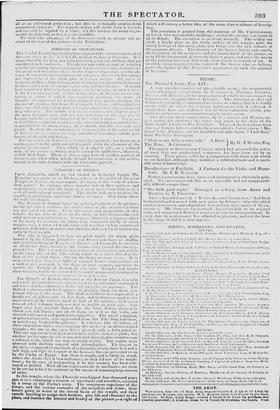l'ANollAllA I)1 , THEBES.
FboM Jerusalem, which we last visited in Leicester Square, .Tr.
Everette I. teen-ports us to ; where, in the midst of the great Temple of Earialle we etc:tempi:Ate the ruing of the "city of it hun- dred gales." Its edifices, whose remains toll of their vastness and niagnifieenee, se,m like the week of a gimla race, t. very thin; is on a tile of such colossal magnitude. The Arabs look mere pigmies, rel• capable of moving the enormous blocks of .stone. Alen creep about the walla lihe lizards.
'Ile Temple of Karnak farms the principal subject of the picture ; for the eye cannot embrace the whole exteie of the ancient city from any one poilit of view. Preai the exient and proportions of this temple, etc are able to jui.ige of the rest ; as they all resemble each
other in their gent ral features. it requires, however, a vigorous elf°, t of the fancy to cuaceive the whole city, eonleosed chiefly of these temples, each a tow in i t' itself, commie-ell ttigether 1.y long avenues of sphinxes. with colossal stattues anti obelisks, and seeming to burden tine earth by their weight.
The city is supposed to have occupied nearly the whole plain bounded by tint Libyan Alma: bin:: mid Jlestrt and those of Arabia, and inclutiin5 the groat Temples of Kai nal:. and Luxor, the lesser ones of Mcdecilet Abuts, Gourmet. the Aherne:eh:la (which Bst.zoNtex- plored),,t:c. 'I hi, last and the two statues of Altetiren arc just visible on the otter side of the Nile, in hich winds in a silver fluted at the foot of el e Lybian chain. (If the dwellings no trace exists. It is conjcctitrti that Limy meet: built of unhernt [hicks, from pontim s of a wall or this material, is the shape of hunt motieds, appearing to encircle 111.• l'untple of Kn,rInn,k our one side. Temples and tombs alone renuein ; and these s«.iii ilS if they ■111 vive until destroyed in
Tli a retl. i..atter t-r.:.it of w,.rlds.'
The TelDpie ul Karnak, dedicated mo the Jove of Egypt, is a mile and a bell in (.4(.1unit-retire, cad can: bated of sent ral courts surrounded
and come-need by colomueles, :I:1.1 propylie, or geteways. 1 he Hall of Columns, and the II .:glineulls of propylie, form the most pro. mitient objects in the scene. The Hill of ColuITIII, is (.011410,4A Of a double row of pillars sixty-six feet high, and in diameter -goal to the space in wheal the visitors stand to look at the picture ; with seven rows of other columns forty-one felt in height on each side. The larger ones have capitals shaped like the lotus flower, alteriletely closed eild full blown ; and all of them, as well as the walls, are covered with carved and painted hieroglyphics. The grand propylon, or principal entrance, was appoetched born the Nile along a dromos, or paved way, bordered by sphinxes. It consists, like all others, of three stupendous butte-Sl.:4,eeetmliying the angles of an obtuse-angled triangle; the one at the apex brine pierced with a lofty gateway. This one appears to have been tinflitislaal, and its surface is plain; but another on the opposite side is covered with hieroglyphic sculptures on a colossal scale, which are very distinctly visible. The courts were adorned with obelisks covered with hieroglyphics. The largest in the view—composed of one block of red granite, ninety-three feet arid a half high, and eight feet square at the base—is the one presented to us by the Podia of Egypt. But there it stands, and is likely to stand, unless the Arabs slice it into millstones, as they did one of its neigh- bours ; for the cost of transporting it to this country has been esti- mated at 40,0001. With all our improvements in mechanics, we seem to be yet far bullied the ancients in the means of removing huge masses of stone.
In this temple, where the Pharaohs worshipped four thousand years
i ago, is none encamping a caravan of merchants and travellers, escorted by a troop of the Pacha's army. The sumptuous caparisons of the troops, and the various costumes of the travellers and Arabs, their horses going to water at the sacred basin of the temple, and their camels kneeling to resign their burdens, give life and character to the place, and Increase the interest and beauty of the picture sight of which will convey a better idea of the scene than a volume of descrip- tion.
The panorama is painted from the drawings of Mr. Cavtimtwoon, architect. wino measured the buildings ; so that the picture's accurate in all its details. The execution is, as ust al, masterly. 'I be setting sun sheds a bright glow on the ruddy surface of the temple, gilds the seamy herbage of the sanely i lain, and brings out the rich colours of the gorgeous dresses. The drawing of the figures, horses and camels, the treatment of the costumes, and the arrangement of the groups, so as to fill the ion egroutuf, deserve the highest praise, and raise the merits of the 'minting to a very high rank, vin wed only as a work of art. It would be doing irjustice to the talent of Al r. Seous, who, we believe, paints the figures of 'Ir. Brut out's peeoraiees, to omit the mention of his name.


























 Previous page
Previous page